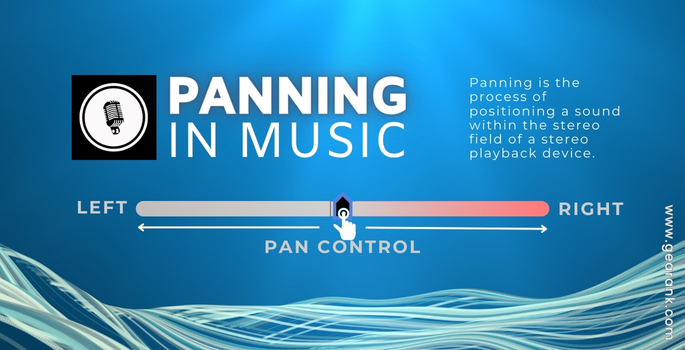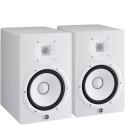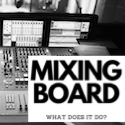
Although it may not seem like a big deal today, panning music was a groundbreaking development in audio production. In the 1930s, EMI audio engineer Alan Blumlein noticed that in “talkies” (the term used for films with sound at the time), having the actor’s voice on one side and the audio on the other was distracting. Blumlein patented his ideas on the matter, including what is now known as the “Blumlein Pair” miking technique, which gave birth to stereophonic panning.
Panning is a fundamental mixing technique that allows you to add spaciousness to your audio mix. By manipulating the stereo image and repositioning different sounds within the track, you can create an immersive listening experience. The technique involves distributing sound sources across the stereo field, which can significantly impact your mix’s balance and perceived loudness.
Automated panning can also add a sense of movement and directionality to your audio. It is a powerful tool that requires a solid understanding of the principles and techniques to use effectively.
In this article, we’ll dive deeper into panning music and why it is crucial to mastering the art of mixing.
Panning Overview
Panning is the process of positioning a sound within the stereo field of a stereo playback device. It involves moving the sound source anywhere between the left and right speakers. This is achieved by using an audio pan pot or a pan control slider to alter the track’s position in the stereo image.
Panning allows for an extended sound experience by creating a larger stereo image. Consequently, music producers and artists use varied pan positions to create a unique and immersive sound.
In modern music production, audio panning is a standard practice in almost all studio tracks. Proper panning allows control over which elements are emphasized in the mix.
Panning Potentiometer: What Is It?
A pan pot or panning potentiometer distributes mono or stereo sounds across the stereo field’s left and right sides.
The pan control splits the input signal into an equal-volume left or right channel. When the pan pot is set to 0, it is considered the center, and both speakers receive an equal amount of sound.
The position indicator of the pan pot informs about the instrument’s panning level, where 50 is a hard pan, and 13 is only mildly panned. The closer the position indicator is to zero, the less the audio track is panned.
On a DAW, the pan pot is represented by on-screen virtual knobs.
Which Systems Allow Panning?
Different playback systems have varying capabilities. It is crucial to note that not all playback systems support panning. Nonetheless, below is a list of the playback systems you may encounter that support panning.
Stereo System – This sound reproduction system utilizes two channels and two speakers to create audio output. A stereo mix is when sounds are dispersed across a stereo field in a stereo playback system. Mono devices are incapable of reproducing the spatial aspects of stereo mixes.
Mono System – A mono-playback system comprises only one speaker or channel. A mono mix is created by panning all sounds towards the center. Both mono and stereo playback systems can reproduce mono mixes by combining or allowing only one channel to pass through.
Surround System – A surround sound system comprises several speakers that work together to create an immersive sound experience, enveloping the listener in a near 360-degree sound field. Unlike basic stereo panning, modern surround sound systems use advanced tools to position sound accurately around the listening area.
The Benefits Of Panning Music
In the process of sound mixing, panning is a technique that creates space for each element in the mix. Separating sounds that have similar frequencies works together with equalization to reduce masking.
It is essential to pan each track in your mix and carefully consider the placement of each sound in the stereo field.
Even if an instrument or sound is panned to the center, assessing its impact on the overall mix is crucial. Panning is critical in creating a well-balanced mix that sounds good on all playback devices.
Does It Matter Where Sounds Are In The Mix?
Audio panning is a subjective technique in music production. Both stereo and mono sounds can be utilized at the producer’s discretion. However, having a general understanding of audio panning basics can be advantageous.
For instance, the left and right channels can be used as a rough guide for panning, but it’s always advisable to experiment with different panning techniques to achieve the desired sound for your mix.
Hard Right And Hard Left Pan
Hard panning is a technique where a sound source is positioned 100% to the left or right of a stereo field. This is commonly used in stereo microphone setups to achieve a realistic replication of the sound source’s placement. Hard panning is proper for instrument recordings captured with XY or Spaced Pair mic positions.
Tracks that require hard panning include pairs of drum kit overhead mics, drum room mics, and double-tracked electric guitars. An acoustic guitar miked up with an X-Y pair can also be hard-panned.
Center Pans
In stereo mixing, center-panned tracks are commonly utilized for steady rhythmic components such as kick drums and snares.
It is also the optimal position for mono sources with substantial low-frequency content, like bass guitar or bass synths.
Moreover, in contemporary mixes, lead vocals recorded in mono are ideally at a center pan.
Off Center Pans
“Off-center” refers to the part of the stereo field that sits between the hard-panned left or right and center-panned channels. By placing sounds in this area, you can create a sense of depth in your mix without sacrificing the valuable space in the center of the stereo field.
Typical examples of sounds that would be panned off-center include additional acoustic or electric guitars, stereo piano recordings, or backing vocals. Different instruments need to be placed around center-panned elements when mixing music.
Is Panning Connected To Volume?
When you pan an audio signal, you are essentially adjusting the volume levels of the left and right channels. This manipulation affects our perception of the sound’s direction.
For example, when a track is duplicated and hard-panned to both the left and right speakers, with equal levels, it will be perceived as originating from the center of the stereo field. This also applies when a mono track is recorded as a stereo track in a DAW.
When the volume level increases in the left speaker while decreasing in the right speaker, the sound will be perceived as moving from right to left. Conversely, when the volume level increases in the right speaker while decreasing in the left speaker, the sound will appear to move from left to right. This is a simple way of looking at audio panning.
Panning In Music And Pan Law
A noticeable volume change occurs when panning tracks as you move along the range. To address this, DAWs can be configured with a pan law compensating for this volume shift, resulting in an even perceived volume across the soundstage. This setting is typically adjusted to account for the acoustics of the room. If you observe a significant difference in volume as you pan tracks, change the pan law settings.
Analog consoles have varying pan laws despite having simple analog pan controls. For instance, console manufacturers such as SSL assume that the console will operate in an optimally treated room and, as such, establish their pan law at 4.5 dB. On the other hand, a typical physical recording console has an average pan law of 3dB for average acoustic treatment. The pan control setting also affects the left and right buses since any audio going through panning that goes into them interacts with any inserts differently.
Pan Your Music
While experimenting with audio panning, you can come up with various soundscapes. To facilitate your journey, here are a few panning techniques and tips that can help you to get started with planning your music.
Where Is The Center?
In an acoustically optimized room with accurately positioned speakers, panned center tracks will project a three-dimensional sound image that appears to be floating between the speakers.
This phenomenon is known as the “Phantom Center”. If tracks panned center do not sound like they are positioned in the middle, the speakers may need to be adjusted. Notably, headphones are not always reliable for accurately manifesting this phantom center.
Establishing the phantom center is crucial for achieving an accurate perception of the spatial elements of a mix.
Try Panning Automation
The panning automation feature in audio mixing software enables users to creatively modify the stereo space of tracks creatively, providing movement to the mix.
By automating the panning of audio tracks, users can create a sense of interest and draw attention to specific elements in the mix. For instance, during a chorus, panning guitars from 75% left and right to 100% creates an impression of expansion, making the chorus sound more impactful.
Rhythmic components such as hi-hats can also be automated to pan left and right, adding interest to a section.
How Is EQ Reacting?
When you pan your tracks from left to right, the equalization of the tracks undergoes minor shifts. This is not because of any inherent property of the track but due to acoustic and psychoacoustic phenomena. Panicking a track on speakers can lead to “Comb Filtering” as each speaker starts to produce a different sound. The tone of the track is also affected by acoustic treatment while panning.
However, this problem is less severe on headphones. But panning on headphones may give you an inaccurate track location in the stereo field as our ears are accustomed to placing objects in space through direct sound and reflections.
If you observe a drastic change in the EQ of your tracks while panning, don’t worry. You can equalize them while centered before panning to obtain the desired result.
Limit Your Panning
The most original choices might occasionally result from limitations. Set your pan pots to certain values so that songs must be panned to 3–5 values. This is helpful if you’re having difficulties determining pan positions.
This will result in some interesting mixes and enable you to hear your audio entirely differently.
Think About The Pan Balance
Modern music production mainly follows a symmetrical approach, with nearly identical left and right channels. This is a departure from older stereo recordings, where elements were placed in the stereo field based on their position on stage. For instance, in early jazz recordings, the drums were often panned to the left or right, while the rest of the instruments were distributed evenly around the stereo field.
Although this approach sounded great on hi-fi speakers, it often leads to a disconcerting experience when listening on headphones. Additionally, some tracks may become omitted entirely when played on mono devices that only reproduce one channel. As a result, modern music production embraces symmetry, with only a few elements slightly off-center. However, there may be exceptions to this rule, depending on the creative decisions made and the intended playback environment.
This same prince applies to volume differences, and this is the reason why audio engineers normalize audio that they mix and master.
Panning also raises concerns about mono compatibility, especially on small devices like phone speakers and Bluetooth speakers, which have a narrow stereo field or playback in mono. When panning, it’s essential to consider that some elements may be lost or obscured, leading to an incomplete listening experience.
Give Yourself Time And Keep Listening
Mixing can be a strenuous task, and it’s not uncommon for crucial mixing decisions to be biased due to fatigue. This includes panning, as it’s easy to overcompensate and clutter the sides of the mix while focusing on center cleanup.
Skillful panning and placement of stereo elements are crucial for achieving a balanced, impactful, and pleasing mix.
If you make minuscule adjustments without noticing significant changes, it’s best to take a break and return to the mix with fresh ears.
Conclusion
Although panning is considered a basic technique, it requires a deep understanding of spatial perception and experience to use effectively. Proper use of the pan knob can help you place your elements precisely, resulting in a mix that is both dense and clear.
To make quick and accurate panning decisions, practicing and calibrating your listening environment is essential.
Automation can also add an element of movement to your mixes, and understanding the pan law is crucial to maintaining consistency.
Once you have a solid foundation in the basics, the pan knob becomes a creative tool for panning music, rather than just a technical instrument.
Frequently Asked Questions
Do You Pan Vocals?
It is recommended to position lead vocals at the center of the stereo field for optimal clarity and presence. On the other hand, background vocals can be panned more widely to achieve a sense of spaciousness and depth.
Does Panning Make Tracks Quieter?
The volume differences while panning depends on the pan law used in your DAW or the circuitry of your console. However, some volume variations may also arise from your environment or your listening device. To reduce the impact of volume differences while panning, it is recommended to calibrate your sound system and use acoustic treatment in your mixing room.
Can Panning Cause Audio Issues?
Panning may cause issues for mono output playback systems like some phones, Bluetooth speakers, and PA systems. This is because they may only output one channel of the stereo mix rather than downmixing a stereo track into mono.
Ensure essential parts of your mix, like lead vocals, kick drum, and snare, are centered. Some stereo width plugins also artificially create doubles.
During a mono downmix, these may introduce phase issues. Avoid using phase-related effects on lead vocals and bass to keep mono compatibility. Panning in music should always be considered when mixing for different listening devices.
Contributors:
- Jerry Borillo – Illustrator





